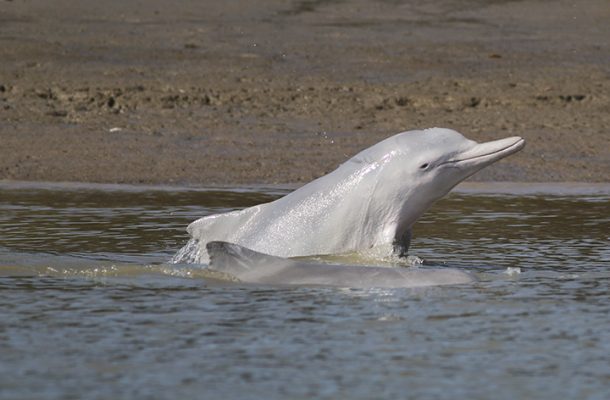Risky business

Australian researchers have for the first time documented the unique risky feeding behaviour known as ‘strand feeding’ in Australian dolphins.
Southern Cross University researcher Dr Daniele Cagnazzi used drones to film a pod of humpback dolphins in the Fitzroy River – one of Queensland’s largest catchments – to document young and adult dolphins ‘stranding’ or ‘beaching’ themselves to catch their next meal.
Dr Cagnazzi has studied the species at Fitzroy River in Central Queensland for 13 years using photos, videos and genetic testing to observe the species.

“Strand feeding occurs where dolphins patrol the mud banks in search of a prey; once the prey has been localised a dolphin swims at high speed toward the shore, catches the fish in its mouth and remains stranded for a short time before sliding gently back into the water,” he said.
“This type of feeding is very risky, as dolphins run the risk of remaining stranded, however, since this behaviour is routinely repeated it must provide an important proportion of their daily feeding needs – dolphins must consume 4-6 per cent of their own body weight in fish each day.
“This feeding only occurs at low tide when the mud banks are exposed, therefore, habitat modification change, increasing flood frequency and sedimentation may affect the ability of dolphins to strand feed to provide their daily food needs. This is something we will continue to monitor.”

Dr Cagnazzi said dolphins around the world have shown different feeding strategies and until now strand feeding had been documented in very few locations internationally and primarily to bottlenose dolphins.
The Fitzroy River is the only known location where Australian humpback dolphins are known to display this behaviour reliably.
“This strand feeding behaviour is conducted primarily by a very well-known family group of humpback dolphins who we’ve identified as long-term residents in the Fitzroy River,” he said.

“The number of dolphins involved in a single episode varies from one to two while the rest of the group is busy in other activities and strand feeding can be full body or partial.”
Australian humpback dolphins are listed as ‘Vulnerable’ in Queensland and in the International Union for Conservation of Nature ‘Red List’ of threatened species. Dr Cagnazzi says relatively little is known about their ecology.
“From here we are aiming to use the analysis of photographic and genetic data to determine if this strand feeding behaviour is culturally transmitted from the mothers to calves,” he said.
Jessica Nelson is a media officer at Southern Cross University in Australia. She has previously worked as a breaking news and education reporter.











